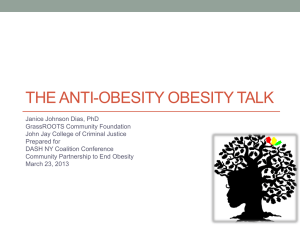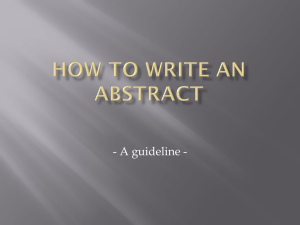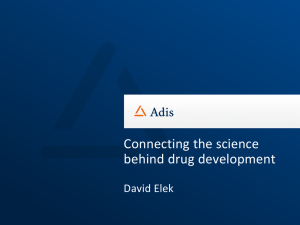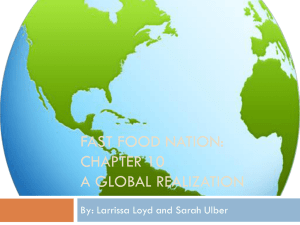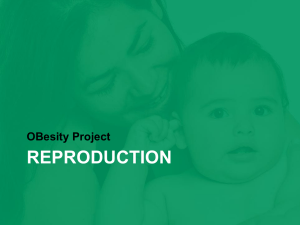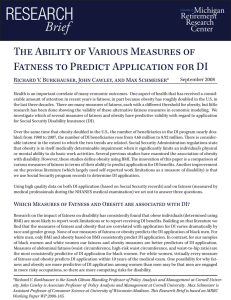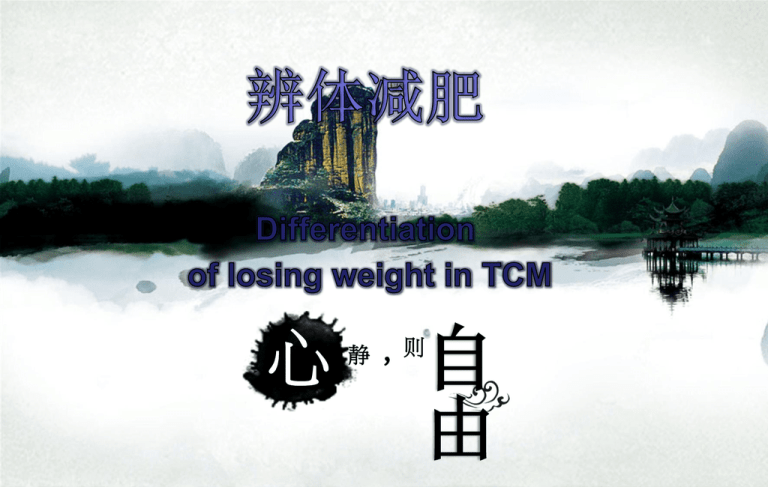
心
静
自
由
,则
心
静
什么是肥胖?
What is obesity?
现代医学
现代医学认为:
肥胖分为单纯性和继
发性两类。前者不伴
有明显神经或内分泌
系统功能变化,临床
较为常见。
Modern medicine
Modern medicine considered
that:Obesity is generally
divided into two categories:
primary and secondary
obesity .
The former is often seen in
clinical practice with no
obvious functional changes in
the nervous or endocrine
system.
后者多伴有内分泌
紊乱,多由于各种
激素,尤其是胰岛
素、性激素、肾上
腺皮质激素、瘦素
等分泌异常引起。
The latter is associated
with endocrine disorders,
due to a variety of
hormones caused by
abnormity, especially
insulin, sex hormones,
adrenal cortical hormone,
leptin secretion.
中医从脏腑辨证分
析肥胖主要与肝、脾、肾
三脏的功能有关,认为肥
胖是由于先天稟赋因素、
过食肥甘以及久卧、久坐
、少劳等引起,常伴有头
晕、疲劳、少气、懒言等
其它症状。
Analysis from visceral syndrome
differentiation, obesity is related to
the function of liver, spleen, kidney
,TCM theory considered that obesity
is the result of qi dificiency and
multi-phlegm due to innate
endowment factors, overeating, as
well as a long time lying fatness
sedentary and less labor. Often
accompanied with dizziness, fatigue,
disinclination to talk, little action
shortness of breath and other
symptoms.
万物归一
/simple
世界标准
World Standards
risk of Related disease
Classification
分类
Normal range
正常范围
18.5-24.9
平均水平
Average level
Overweight
超重
25-29.9
轻中度增高
肥胖
>30.0
严重增高
Mild to moderate
increase
Severe increase
Obesity
BMI 体重指数(kg/m2)
相关疾病危险度
亚太地区标准
Asia-Pacific Standard
分类
Normal range
正常范围
18.5-22.9
平均水平
Average level
Overweight
超重
肥胖
严重肥胖
23-24.9
25-29.9
>30.0
轻度增高
中度增高
严重增高
Mild increase
Moderate increase
Severe increase
Obesity
Severe obesity
体重指数(kg/m2)
相关疾病危险度
risk of Related disease
Classification
腹型肥胖
体重指数正常或不很高
腹围: 男性大于101厘米
女性大于89厘米
或腰围/臀围比值
男性大于0.9
女性大于0.85
在判断胖与不胖和危害大小
时,不仅要重视体重指数的高低,
更要测量腰围的粗细。
Central obesity
Normal or high body mass index
Abdominal circumference:
male≥101cm;female≥89cm
Or waist / hip ratio:
male≥0.9;female≥0.85
Note:
When determining fatness or nonfatness and the severity of harm,
not only pay attention to the level of
the index, but also measure the
thickness of the waist.
肥胖分虚胖(中心性肥胖)和实胖(均一性肥胖)
Obesity concludes puffiness (central obesity) and real
fatness(uniformity of obesity).
古人把肥胖分成肉人(实胖) 和膏人(虚胖)。
The ancients divided the Obesity into the meat obese body
(real fatness) and the creamy body (puffiness).
虚胖
1.进食少
2.易疲劳
3.手脚易觉肿胀,下蹲时小
腿肿胀感强烈
4.脸色偏白或泛青,怕冷汗
少,多白痰
5.运动少,肌肉松弛
6.尿液颜色清淡
7.夜间多梦
(有3项以上符合就属于虚胖
体质)
1
2
3
4
5
6
7
Puffiness
Impaired appetite
Fatigue
Edema of hands and feet, a strong
sense of swelling in legs when
squatting
White or cyan complexion,
aversion to cold , less sweating,
more white phlegm
Less exercise, muscle relaxation
Light urine.
Dream-disturded sleep
( match three or more items above,
,the physique belongs to puffiness.)
实胖
1.多食易饥
2.易便秘,大便≤3次/周
3.外表多肉,结实
4.经常感到口干舌燥,多浓痰
5.脸色较红润
6.小便赤、浊、黄、深
7.易做噩梦
Real fatness
1 Polyphagia,polyrexia
2 Easy constipation(stool ≤ 3 times
/ week)
3 Fleshy, firm appearance
4 Often dry mouth,thirst, more
thick phlegm
5 Relatively rosy face
6 Reddish,turbid,brownish,
dark urine
7 Nightmares
Body Acupuncture
主穴(腹八针):中脘、关元或中极、滑肉门、
天枢、外陵
Acupoint Prescription(8 points of abdomen):
Zhongwan(RN12),Guanyuan(RN4),orZhongji(RN3)
,Huaroumen(GB30),Tianshu(ST25),Wailing(ST26)
脾虚湿滞:
肥胖浮肿、疲乏无力、肢体
困重、尿少、纳差、腹满,
脉沉细、舌淡苔腻。
取穴:水分、手三里、足三
里、阴陵泉、丰隆、三阴交
。
Spleen deficiency and dampness
stagnation:
Obesity, edema, fatigue, weakness,
body weight difficulties, oliguria,
anorexia, abdominal fullness. The
pulse thin and deep, the pale tongue
with a greasy coating .
Points:Shuifen(RN9) ,
Shousanli(Li10),Zusanli(ST36
),Yinlingquan(SP9),Fenglong
(ST40)Sanyinjiao(SP6)
湿热内盛:
头目眩晕,头重,胸闷,
食欲不振,呕恶痰涎,肢
体困重,或见形体丰肥,
或闭经,舌苔黄腻,脉滑
取穴:大横、腹结、四满、
曲池、合谷、阴陵泉、丰
隆、内庭
Damp-heat Accumulation in the
interior:
Dizziness, headache, heavy head, chest
tightness, palpitations, loss of appetite,
nausea and vomiting phlegm, body
weight difficulties, or the fat body, or
amenorrhea, the yellow and a greasy
coating,the slippery pulse.
Points: Daheng(SP15), Fujie(SP14)
,Siman(KI14), Quchi(Li11),
Hegu(Li4),Yinlingquan(SP9),
Fenglong(ST40),Neiting(ST44).
胃肠实热:
头晕、消谷善饥、肢重困楚、
怠惰、口渴喜饮,舌红苔黄
腻、脉滑数。
取穴:大横、腹结、曲池、
支沟、合谷、丰隆、内庭。
Heat Stagnation in the Stomach
and Intestines:
Dizziness,polyrexia, bodily
heaviness, sloth, thirst with desire
to drink. Slightly slippery pulse
number,the red tongue with a
yellow ,greasy coating,the slippery
and rapid pulse.
Points:Daheng(SP15),Fujie(SP14),
Quchi(Li11),Zhigou(SJ6),Hegu(Li4
),Fenglong(ST40),Neiting(ST44)
脾肾阳虚:疲乏畏寒,腰酸
腿软,阳萎阴冷,便溏、舌
淡或淡紫或淡暗、脉沉细无
力。
取穴:命门、肾俞、大赫、
血海、足三里、阴陵泉、三
阴交。
Spleen and Kidney yang Deficiency :
Fatigue, aversion of cold, soreness and
weakness in the lower back and knees,
impotence and cold scrotum,loose
stool, the pale or lavender or turb
tongue, deep ,thin and weak pulse.
Points:Mingmen(Du4),Shenshu(BL23),
Dahe(KI12),Xuehai(SP10),Zusanli(ST3
6),Yinlingquan(SP9),Sanyinjiao(SP6)
肝郁气滞:
胸胁胀闷,胃脘痞满,月经
不调或闭经,失眠多梦。脉
细弦,舌苔薄,舌质暗
取穴: 太冲、行间、期门、
蠡沟、曲泉、膻中
Liver qi stagnation:
Chest distress and epigastric
distension, irregular menstruation
or amenorrhea, insomnia, dreamdisturded sl-eep,the string and
thin pulse, the dark tongue with a
thin coating.
Points:Taichong(LR3),
Xingjian(LR2),Qimen
(LR14),Ligou(LR5),Ququan(LR8)
, Danzhong (RN17)
取穴:口、食道、饥点、
内分泌、脑、胃、脾、三
焦、膀胱、小肠、交感、
皮质下
Points:
Mouth, esophagus, hunger
point, endocrine, brain,
stomach, spleen, triple
energizer, bladder, small
intestine,thympath-etic,
subcortex
Other ways to losing weight
刮痧
拔罐
Scrapping
Cupping
经络
饮食
Meridians
Dietary
谢谢
Thanks!


